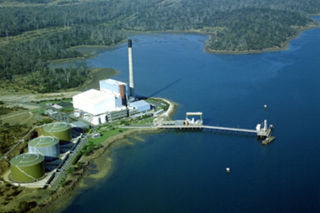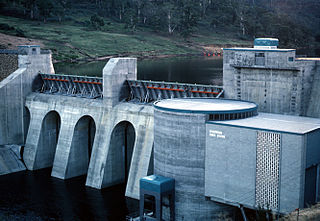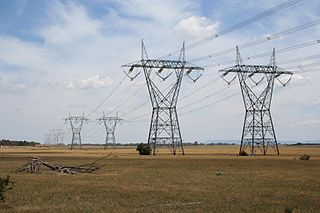
Hydro Tasmania, known for most of its history as the Hydro-Electric Commission (HEC) or The Hydro, is the trading name of the Hydro-Electric Corporation, a Tasmanian Government business enterprise which is the predominant electricity generator in the state of Tasmania, Australia. The Hydro was originally oriented towards hydro-electricity, due to Tasmania's dramatic topography and relatively high rainfall in the central and western parts of the state. Today Hydro Tasmania operates thirty hydro-electric and one gas power station, and is a joint owner in three wind farms.

Aurora Energy is a Tasmanian Government-owned electricity retailer in Tasmania, Australia.
The National Electricity Market (NEM) is an arrangement in Australia's electricity sector for the connection of the electricity transmission grids of the eastern and southern Australia states and territories to create a cross-state wholesale electricity market. The Australian Energy Market Commission develops and maintains the Australian National Electricity Rules (NER), which have the force of law in the states and territories participating in NEM. The Rules are enforced by the Australian Energy Regulator. The day-to-day management of NEM is performed by the Australian Energy Market Operator.

Ergon Energy Network is a subsidiary company of Energy Queensland Limited (EQL) a Government owned corporation owned by the Government of Queensland. It distributes electricity to around 763,000 customers across Queensland, excluding South East Queensland through a distribution network regulated by the Australian Energy Regulator (AER) who set the prices that Ergon is allowed to charge for distribution.

The Bell Bay Power Station was a power station located in Bell Bay, on the Tamar River, Tasmania, Australia, adjacent to the Tamar Valley Power Station, with which it was often confused. It was commissioned between 1971 and 1974 as an oil fired thermal power station, and was converted to natural gas in 2003, after the commissioning of the Tasmanian Gas Pipeline, a submarine gas pipeline which transports natural gas from Longford, Victoria, under Bass Strait, to Bell Bay, Tasmania. As the power station's primary role was to provide system security in the event of drought for Tasmania's predominantly hydro-electric based generation system it only was rarely called on to operate, resulting in intervals of five to eight years between periods of significant use. After the commissioning of Basslink in 2006, the power station was decommissioned in 2009.

The Meadowbank Power Station is a run-of-the-river hydroelectric power station located in the Central Highlands region of Tasmania, Australia. The power station is situated on the Lower River Derwent catchment and is owned and operated by Hydro Tasmania.
The Connect Tasmania Core is the name used by the Government of Tasmania to refer to a fibre optic communications network linking all major cities of Tasmania to Victoria. The government intends to offer access to the network in order to facilitate a more competitive telecommunications industry.

SA Power Networks is the principle electricity distributor in the state of South Australia, delivering electricity from high voltage transmission network connection points operated by ElectraNet. It is the successor to the Electricity Trust of South Australia.

Energy in Victoria, Australia is generated using a number of fuels or technologies, including coal, natural gas and renewable energy sources. Brown coal, historically, was the main primary energy source for the generation of electricity in the state, accounting for about 85% of electricity generation in 2008. The amount of coal-fired power has decreased significantly with the closure in 2017 of the Hazelwood power station which supplied around 20% of Victoria's electricity, and to a lesser extent with the exit of Anglesea power station in 2015. Brown coal is one of the largest contributors to Australia's total domestic greenhouse gas emissions and a source of controversy for the country. Australia is one of the highest polluters of greenhouse gas per capita in the world.
Transgrid is the manager and operator of the high voltage electricity transmission network in New South Wales and the Australian Capital Territory, Australia, and is part of the National Electricity Market (NEM). The company's offices are located in Sydney, Newcastle, Orange, Tamworth, Wagga, and Yass.
Tamar Valley Power Station is a $230 million natural gas-fired power station located in Bell Bay in the Tamar Valley, Tasmania. It is owned by Hydro Tasmania, and is immediately adjacent to the decommissioned Bell Bay Power Station, which is also owned by Hydro Tasmania.
The Australian Energy Market Operator (AEMO) performs an array of gas and electricity market, operational, development and planning functions. It manages the National Electricity Market (NEM), the Wholesale Electricity Market (WA) (WEM) and the Victorian gas transmission network. AEMO also facilitates electricity and gas full retail contestability, overseeing these retail markets in eastern and southern Australia. It is additionally responsible for national transmission planning for electricity and the establishment of a Short Term Trading Market (STTM) for gas.
The Basslink electricity interconnector is a 370 km (230 mi) 500 MW (670,000 hp) high-voltage direct current (HVDC) cable linking the electricity grids of the states of Victoria and Tasmania in Australia, crossing Bass Strait, connecting the Loy Yang Power Station, Victoria on the Australian mainland to the George Town substation in northern Tasmania. Basslink is bidirectional and enables Hydro Tasmania to supply some of the peak load capacity to the Australian mainland and take some of the excess power from the mainland when the generation on the mainland exceeds the demand.

Powerlink Queensland is an electricity transmission system operator owned by the Government of Queensland which operates the high-voltage electricity transmission infrastructure in Queensland.

Tasmanian Networks Pty Limited, trading as TasNetworks, is a Tasmanian Government State owned company that is responsible for electricity transmission and distribution throughout Tasmania. It also owns and operates a telecommunications network throughout the state.

The electricity sector in Australia has been historically dominated by coal-fired power stations, but renewables are forming a rapidly growing fraction of supply. In 2021, Australia's electricity production reached 265 TWh, with coal accounting for 52.9% and natural gas for 18.8%. Renewable sources, comprising solar, wind, hydro, and bioenergy with waste, collectively made up 26.7% of the total electricity generation mix.
The 2016 Tasmanian energy crisis was an ongoing energy storage situation in the state of Tasmania, Australia in 2016. Two years of high volumes of energy exported to Victoria via the Basslink HVDC cable, followed by low rainfall, and a fault which rendered the cable inoperable, resulted in record low storage levels in Tasmania's hydro-electric system. This resulted in a number of contingency plans to be enacted by Hydro Tasmania and the Hodgman Government.
Marinus Link is a proposed 750 megawatt capacity high voltage direct current (HVDC) electricity interconnector, to strengthen the connection between the Australian states of Tasmania and Victoria, on Australia's National Electricity Market. Due to inflation, Marinus link was scaled back from an initial plan of 1500 MW via two cables, down to 750 MW via one cable. It involves approximately 250 km of subsea cables and approximately 90 km of underground land cables. Marinus Link will also incorporate significant optical fibre capacity for system control, with the remaining capacity available to strengthen telecommunications and data connectivity between the regions. Marinus Link will be supported by approximately 220 km of high voltage alternating current (HVAC) of proposed transmission developments in North West Tasmania, known as the North West Transmission Developments (NWTD). Collectively, Marinus Link and the North West Transmission Developments are known as Project Marinus. In October 2022, authorities pledged loans for the project, as well as supporting facilities such as pumped hydro in Tasmania.
Tasmania, as an advanced economy with a globally high standard of living, uses a great deal of energy. Distinctive features of energy use in Tasmania include the high fraction of hydroelectricity usage, the absence of coal-fired electrical generation, relatively light usage of natural gas, particularly for domestic use, and a wide use of domestic wood-burning stoves. Energy production through hydroelectricity has been politically contentious, and conflicts over Tasmanian hydroelectric projects were integral to the formation of Green parties in Australia and across the world.

Video City was an Australian home video rental business that offered titles on VHS, DVD, Blu-ray and Ultra HD Blu-ray, as well as console video games, for rent. At its peak, Video City operated 26 stores nationally; 21 in Tasmania, with a further five stores located across Victoria and Queensland.











